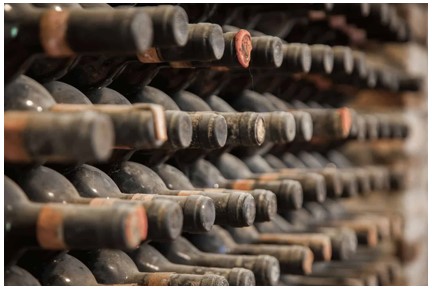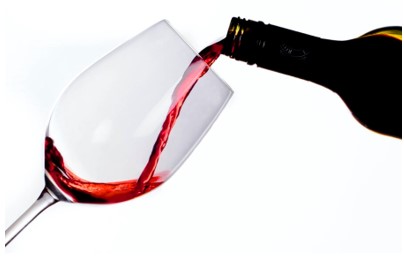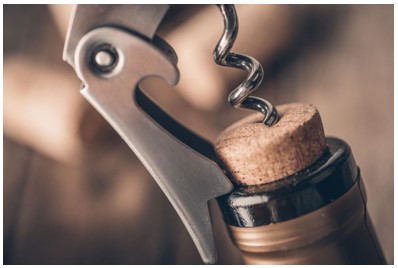HOW TO HAVE YOUR WAY WITH A WINE BOTTLE
How many times have you been to a restaurant, ordered a delightful bottle of wine and had it opened for you by a waiter whose competent and complete control of the procedure left you enthralled and perhaps even a little bit jealous? You may be surprised to know that you’re not alone. My professional diagnosis is that you’re suffering a mournful malady experienced by wine drinkers the world over – Wine Opening Anxiety Disorder – the fear of opening a wine bottle. Sadly, this WOAD affliction affects novice wine drinkers and aficionados alike. Those days are over, my friend, because I am about to give you a lesson in opening a bottle of wine that will calm your concerns and alleviate your apprehensions.
Yes, neighbor, I am going to rid you of that common feeling of inadequacy you get when someone requests that you open the wine at a party. I am going to dispel all those myths you have put stock in over the years about how hard it is to open and pour wine. In short, by the end of this text you will have become a master of your wine-opening fate. You, yes you, will no longer fear the ridicule of your dinner guests because you will have mastered the time-honored technique of opening and serving a bottle of wine with the elegant ease and sophisticated savoir-faire of a seasoned sommelier.
I hear your voice of doubt. I am compassionate about your concerns. But make no mistake about it, you can do it! If you stow your anxieties in your mental attic for a few moments, I’ll prove to you how unfounded they are. When you think about it calmly, removing the cork from a bottle of wine is really a rather simple process that, in truth, requires very little skill or effort. Much of the mystique of wine and opening wine comes more from ignorance of the bottle and not the removal of the cork.
To begin properly, a few essentials must be at hand. Among these you should include a waiter’s corkscrew, a cloth napkin, an intriguing bottle of wine and a wineglass. Oh, and last, but most importantly, an inspiring thirst, for without a thirst borne of desire there is no point in opening the bottle. Why, you may as well use the bottle for a doorstop! These five elements are all you need. Once you have coupled these with the appropriate technique that you are about to receive, there will be no end to the joys and delights that await you in the wine world.

Let us start with the corkscrew. Any casual perusal of your local wine and liquor emporium will most certainly reveal to you that there is in existence a multitude of tools and utensils available to be engaged in the removal and reinstating of corks. In the few hundred years since the replacement of wax by cork in the sealing of wine bottles, human ingenuity has produced many corkscrew designs. Don’t let the options bewilder you! While they all achieve the same goal – opening the bottle – they vary in complexity by degrees. Today’s exercise does not call for the ring-shaped T model, the Victorian double-spiral, the butterfly, the Ah-So two prong, the Wing, the Screwpull, the Rabbit or the Coravin inert gas air needle. No, for our purposes here today, we shall abide by the maxim that less is more and therefore will choose one of the simplest models to use and one of the most abundantly available. We will employ the services of the traditional waiter’s corkscrew, also known in the trade and the waiter’s friend for its’ efficient mechanics and its economical use of space in a waiter’s pocket.
The waiter’s friend is not unlike a pocketknife. From its body three useful utensils flip out, each possessing a distinctive purpose for the task at hand. On the outer shell is a claw or jack, below which is concealed an open spiral rod known as the worm and on the outer shell opposite the claw is a recessed blade. The jack is used to gain leverage on the cork when retrieving it from the bottle. While corkscrews have only been around since the 17th century, their dependability is unquestionable. The appellation corkscrew is a bit of a misnomer now as it is a term applied to a broad range of wine-openers such as those suggested by the partial list above, some of which possess no worm at all. As for the waiter’s friend, provided that it is made largely of metals, it will last almost indefinitely or until the worm bends and breaks or the blade dulls to the point that it is unserviceable.
Taking the corkscrew in both hands, use a fingernail or the tips of two fingers to pull out the recessed blade. Turning the instrument over, flip out the jack. Last, but not least, pull out the worm until it is perpendicular to the body of the corkscrew. Your wine-opener is now ready for active duty! Get comfortable with it. Feel the sharpness of the blade and the strength of its coiled steel worm. Once you have become familiar with its various assets, close the tools back into the corkscrew’s frame and let’s begin the wine opening procedure by returning to the bottle. The type of wine that you choose for this exercise is entirely up to you. I suggest that you obtain a wine that you are familiar with for it will serve as a just reward for your labors.
Always keep the bottle upright. This will allow any natural sediment of the wine to remain at the bottom of the bottle. It will also enable your guest, if you have one, to read the wine label correctly! I will present the following directions for those who favor their right hand as the majority of the population is right-handed. For those of you who are left-handed don’t feel left out. Simply reverse the procedure to accommodate your needs. Grasp the neck of the bottle with your left hand. If you are comfortable with the weight of the bottle in your hand you may perform the wine opening with the bottle held aloft. This is known as the French Service style. If you feel that the bottle is too heavy or awkward then place it firmly on a solid surface such as a table or countertop. This is known as the American Service style. Either style is fine. It really comes down to you. In the beginning, function will serve over form and aesthetics will be usurped by ability. The most important factor is that you are comfortable. The greater your comfort the greater the ease with which you will perform this task.
You should now have a firm grip on the neck of the bottle with your left hand. In your right hand is the waiter’s friend with the blade open. Rest the edge of the blade against the neck of the bottle, just below the protruding lip. Applying firm pressure to the foil, lead or wax, forcefully imbed the blade into the seal. Using your right thumb as a balance, begin to draw the blade clockwise around the neck of the bottle, cutting the seal.
You will probably find that you must turn the bottle to accomplish this task. After about three turns, the seal should be sufficiently severed. If it is not, repeat the procedure until completed. Sometimes the seal will fall away cleanly from the lip and other times it will stick to the top of the cork a little. If it sticks, simply pull the blade up the top of the neck and across the top of the cork, scraping the seal into the palm of your hand. Set the crumpled seal aside, you won’t need it anymore. Fold the blade back into its nest in the body of the wine-opener as you will not need it again for the remainder of the procedure.

If the surface of the cork appears dirty from wine or crystallized sugar, use one of the edges of your cloth napkin to wipe off the top of the cork and bottle. It should now be clean and none of the residue will contact the wine as the wine is being poured. Set your napkin aside, but keep it close as we may need it again soon. See how easy that was? I know you’re still with me, so we’re going to move on to the next step of actually removing the cork.
Grasp the worm and pull it away from the body of the wine-opener until it is fully perpendicular and pull the wine jack open, too. While palming the body of the wine-opener slowly slide the index finger of your right hand down the shaft of the worm until the tip of your finger rests at the tip of the worm. The jack should be cradled in the well between your index finger and your thumb. At this juncture, the corkscrew will almost feel like a gun in your hand. Once again, grasp the neck of the bottle with your left hand. With the corkscrew in your right hand, use your index finger as a guide as you approach the top surface of the cork. Locate the center of the cork and gently rest the tip of the worm on the top of the cork. Notice how the open tine is set perfectly to pierce the cork.
Insert the worm straight into the cork until you have turned the corkscrew about four times or until there is but one turn of the worm visible above the cork. It is pertinent to note here that corks are of varying lengths and densities. Not all corks have the same density and so some will require firmer downward pressure than others. Constant and consistent pressure will prevail. As for lengths, different bottle shapes use corks of different lengths and, to a degree, the quality of a wine can determine the type of cork used by the vintner, with more expensive wines of better breeding possessing longer corks.
The worm must run sufficiently deep into the cork or you risk breaking the cork when you attempt to remove it. I must also advise you not to imbed the worm too deep into a cork as you run the risk of piercing the opposite end. If you do, the result will be pieces of cork and cork dust floating in an otherwise pristine wine. Even if this should happen, fear not, the fragmented cork will not harm the wine, but it will give it more texture and few people need that much roughage! Now back to the task at hand.
The worm is now as fully imbedded in the cork as you desire. When flipped down onto the lip of the bottle the flat narrow ridge of the jack should rest comfortably on the top of the bottle. If it does not, you may need to turn the worm in one direction or another until the jack is flush. The jack is now ready to use as a lever. While still grasping the bottle in your left hand, raise your left thumb up and lay it against the outside of the jack. With your right hand, grasp the body of the wine-opener and slowly begin to pull the body straight up from the bottle. This combined effort will force the cork out of the bottle.
Avoid the temptation to jerk the corkscrew or bend the cork towards your body. If you jerk, the cork could fly out of the bottle and you could spill the wine. If you bend the cork toward you, there is a great risk of breaking the cork, especially if it was not sufficiently speared by the worm. Slowly and with even pressure, remove the cork from the bottle. If the jack loses contact and becomes ineffective, as is often the case for longer corks, it may be necessary for you turn the worm deeper into the cork to imbed it further and use the second flat stage of your jack if it has one. Or grasp the exposed cork and manually give it the turn or turns it needs to be successfully removed. Either way, you have just removed the cork from the bottle and you are so close to being done that you can practically taste the wine!
Should the cork break due to bending or fragility, don’t despair. It happens to all of us! Your choice then is to dig the worm deeper to try to reseat it into the cork remaining in the bottle or push the broken cork into the bottle. You can pour the wine into another vessel – a clean decanter, pitcher or even a vase, in a pinch. Pour the wine through a fine wire mesh strainer or even a coffee filter to separate the cork bits from the wine. It isn’t the end of the world. I’ve been opening wine bottles for over 40 years and I still get a broken cork now and then. Sometimes it’s the cork and not the corkscrew. Practice helps.
Once you have removed the cork from the bottle, grasp the cork in your left hand and the wine-opener in your right. Turning the corkscrew counter-clockwise will disengage the cork from the worm. You may now fold the worm back into its home and rest the jack flush with the body of the wine-opener. At this point, you may do whatever you like with the cork. Some people like to smell the cork while others like to play with it, feeling it for firmness and moisture. The choice is up to you. Bear in mind that by now the cork has either served its designed function or it has not and the only way to determine this is to taste the fruit of the vine itself. Taking your ever-ready napkin, make one final pass over the surface of the opening of the bottle to wipe off any dust, sediment or cork. Once you are satisfied that the lip of the bottle is clean you are ready to pour and taste.

Well, was it worth the wait? I’m sure that it was. You can now appreciate what others have known for a very long time: it isn’t really that hard to open a bottle of wine. The perfect mix of patience, experience and attention to detail will become second nature to you in no time. Why, I’ll bet that soon you’ll be volunteering to open the wine at your next dinner party or book club night so that you can show off your new technique. The only mystery, my friend, is why you waited this long to find out how easy it really is to open a bottle of wine! Well, consider those days behind you. Not long from now, with a little practice, you’ll be teaching someone else everything you know about the mysteries of opening a bottle of wine. I hope our little lesson has put you more at ease and on the road to a full recovery from WOAD. And for the visual learners in the reading group who found this a bit…verbose…the internet awaits with an endless variety of videos on how to open a bottle of wine. That said, our session this week is over and the good doctor is going to have a glass of wine. All of this wine bottle opening talk has me thirsty!














Comments